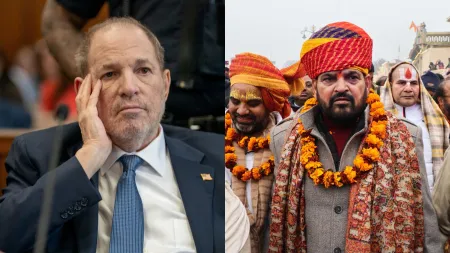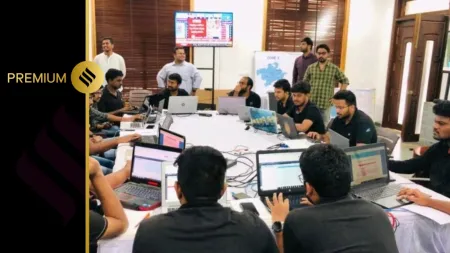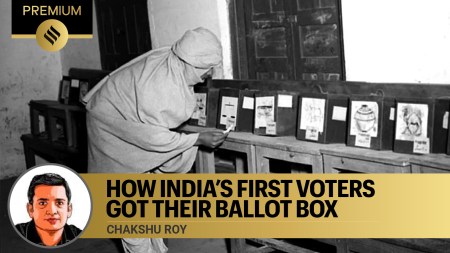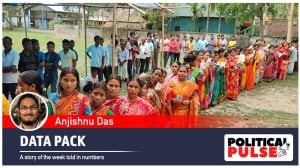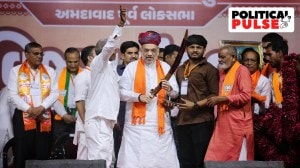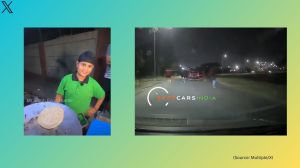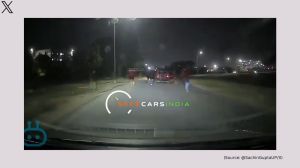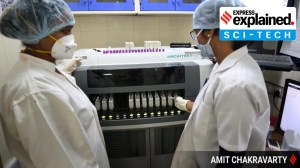- India
- International
‘School to hospital, most of my life has been spent walking’
For Gumudumaha, all roads lead through stretch where 5 were killed by Odisha anti-Maoist force.
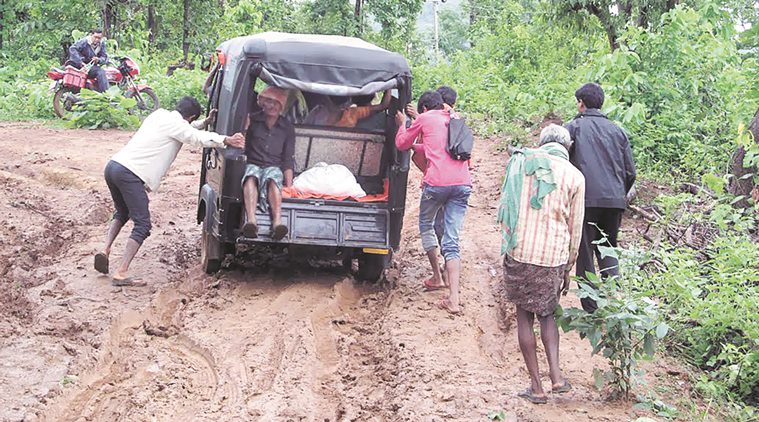 An auto being pushed through slush, which is what the road to Gumudumaha looks like after rains. The 5 were killed in an auto on this road.
An auto being pushed through slush, which is what the road to Gumudumaha looks like after rains. The 5 were killed in an auto on this road.
THE NEAREST bank where they get their NREGS money and the closest hospital to take care of any serious ailments are 45 km away. For rationed rice, they go 15 km to the panchayat office. Patients can’t get an ambulance, so must be carried on upturned cots for at least 7 km. The primary school is a distance of a few kilometres, and the nearest college 15 km away. About 15 km to Gumudumaha, the cellphones die too.
“Most part of my life,” says Gumudumaha tribal Bhaskar Mallick, 50, “has been spent walking.”
Navigating the distance between Gumudumaha and Baliguda town was what five villagers, including a two-year-old boy, were doing on July 8 night when they were shot dead by the Odisha Police’s Special Operations Group (SOG). Seven villagers were injured. The SOG suspected the 16 villagers, packed into one autorickshaw, to be Maoists. The National Commission for Scheduled Tribes investigating the matter said the SOG needed “psychiatrist test” to have thought so.
On good days, the road to Gumudumaha, a lush-green village located amidst the Eastern Ghat mountains, in Kandhamal is a dirt track. In the monsoon, it is a slush, covered by silt that has attained a reddish hue due to laterite dust sprayed on during NREGS work.
In that, the story of Gumudumaha and its 40-odd BPL families, including Dalits and tribals, is not unlike that of many of the 327 other villages in Odisha’s Baliguda block. If there are no heavy showers, autorickshaws and motorcycles can reach, else tractors, travelling in fits and starts, are the only mode of travel.

Kerosene lamps are the sole source of light, with Gumudumaha among the 153 villages of Kandhamal yet to be electrified. With no provision for drinking water, villagers collect water from nearby streams. The lone BSNL cellphone signal dies around Kurtamgarh village, 15 km away.
[related-post]
Watch Video: What’s making news
“Gumdumaha is a village living in a time warp,” says former Congress MP and tribal leader Pradip Majhi, who visited the village on a tractor after the shootout.
On July 10 morning, Setha Mallick, a student of Plus 2 (Class XII) Arts at Tumudibandha college, is trying to make his way to the institution. It has been raining intermittently for three days, and a heavy drizzle has started again. The 17-year-old tries pedalling his rickety bicycle faster, but the tyres get buried in slush. Mallick gives up, deciding to drag the cycle instead.
“It’s going to be a long way, maybe two hours,” he sighs, talking about the 15-km distance.
Some others have got off their motorcycles and are dragging them. The road is flanked by dense forests, with small churches and paddy and jowar plantations dotting the landscape. Those on foot keep a wary eye on the occasional snake holes.
As an autorickshaw goes past, Mallick smiles, “It may reach the nearby village in a couple of hours.”
On July 8 evening, the 16 villagers of Gumudumaha, most of them NREGS labourers, had got onto one such autorickshaw to get home from Baliguda, 45 km away. They had gone to the town around 8 am that day, to withdraw their NREGS money from SBI’s Baliguda Branch and to buy provisions. At 6 pm, after paying
Rs 1,300 to the driver, they had got into the vehicle with their children, rice, kerosene, flour, vegetables, eatables and odd trinkets.
At around 9 pm, as the villagers had reached a culvert near Gumudumaha, the wheels of the auto had got stuck in the slush. The villagers had got down to push while a few others had used the break to relieve themselves near a nullah and to wash the dirt from their feet. Around 20 minutes later, the auto had been pulled out of the mud. Just as they were about to get in, the 15 SOG jawans, some of them allegedly crouching as close as 4-5 metres away, had opened fire.
Bandigul Mallick (42), Mediali Mallick (32), Kimari Mallick (42), Kukal Digal (43) and two-year-old Gihej, who was in his mother Sunita Digal’s lap, were killed. Sunita and husband Luto were among the seven injured. Others escaped by jumping into the nearby ditches, carrying with them a six-month-old infant and a six-year-old girl.
According to the villagers, the SOG men then held them at gunpoint till 11 am the next day, not allowing the injured to be taken to Baliguda as they wanted to collect empty cartridges from the firing spot on the way. However, IGP (Southern Range) Amitabh Thakur says that no SOG men had gone to the spot the next morning, and that only CRPF personnel accompanied by the state police had gone there to ensure no evidence was destroyed. “Rather, we offered to take the injured to hospital. But the villagers pelted stones,” he says.
The seven injured were eventually carried by the villagers for around 7 km in cots and later in autos to the Baliguda Sub-Divisional Hospital.
Standing near the pyre of his wife Kimari, Bibi, 50, says he is too scared to venture out of the village now, even to collect his rice under the National Food Security Act, from the Parampanga gram panchayat office. Bibi escaped that night with six-year-old daughter Chandrika. “Who wants to die like this?” he says.
Collecting forest produce is the main livelihood for most tribals here. But even venturing into the Malapanga forests looks fraught with risk, add others. “The jawans (SOG men) destroyed my family. After this, I can never go out in the evening,” sobs Gihej’s grandmother Mina Digal.
“Only a few of us have cultivable lands and the plots given under the FRA (Forest Rights Act) have not been demarcated. For most part of the year, we make a living as NREGS labourers,” says Tapala Mallick, whose wife Mediali was killed in the firing.
But for manual work too, villagers have to make it to Baliguda or Tumudibandh. And they must return before 8 pm, given the long way home. Later, to withdraw their wages, they again have to go to Baliguda. The Tumudibandha post-office, relatively nearer at 15 km, doesn’t have a savings account facility.
District Collector Reghu G claims the 15-km road between Gumudumaha from Kurtamgarh village would be made pucca soon. “We are going to ask the Rural Development Department to make an all-weather road,” Reghu says. Kurtamgarh is connected to National Highway 59.
Gulara Digal, whose father Kukala was killed while mother Gadisi was injured in the July 8 incident, says the promise is of little use. “Can all the money the government gives bring back my father? Why did the government not build a road to the village?”
A 60-year-old tribal who doesn’t want to be identified has a more basic question: who exactly is the government fighting? “The jawans think we are Maoist sympathisers. There are no Maoists here. I don’t want any road or facilities. I just want the government to take away all the jawans,” she says.
May 06: Latest News
- 01
- 02
- 03
- 04
- 05





